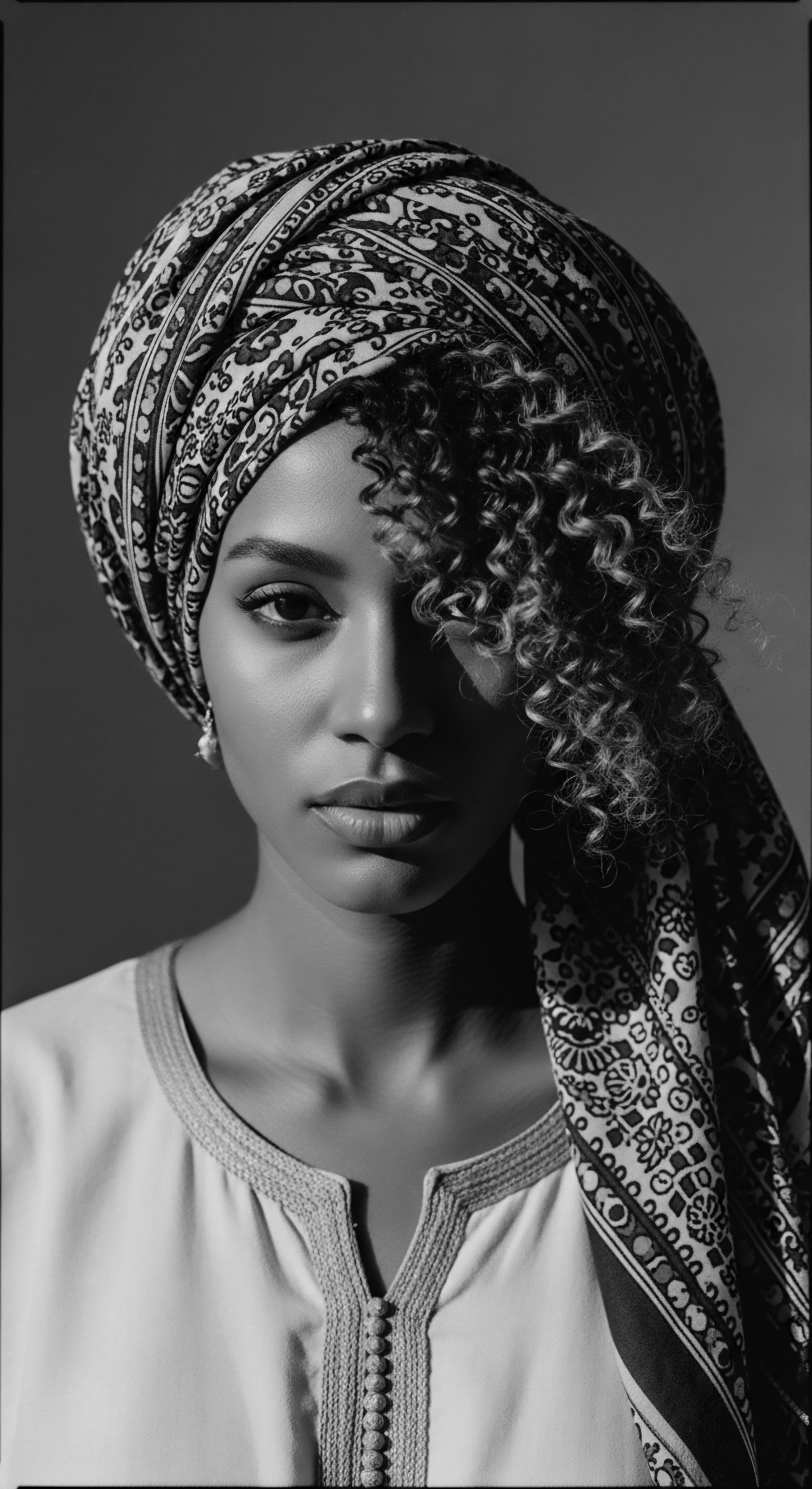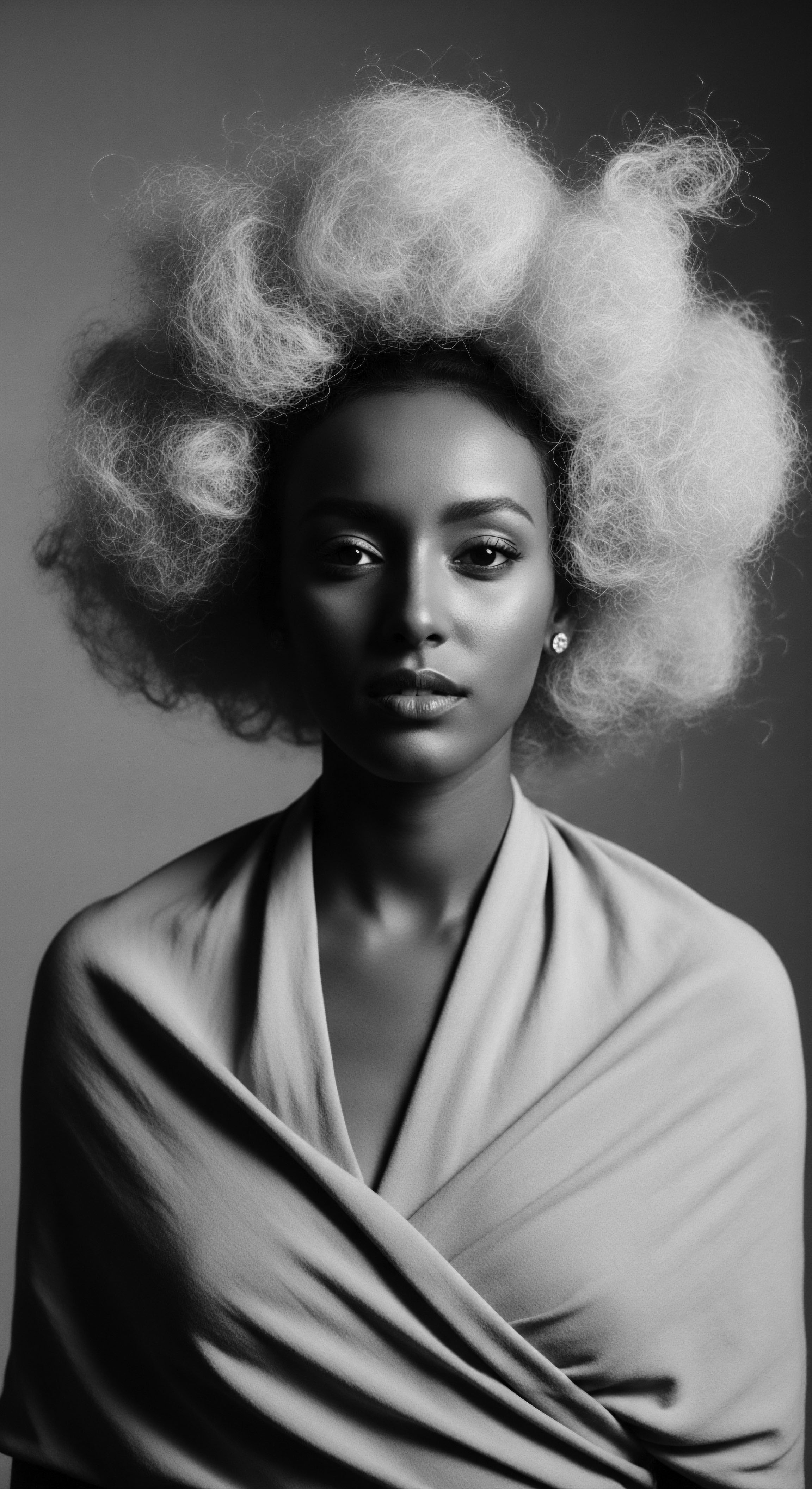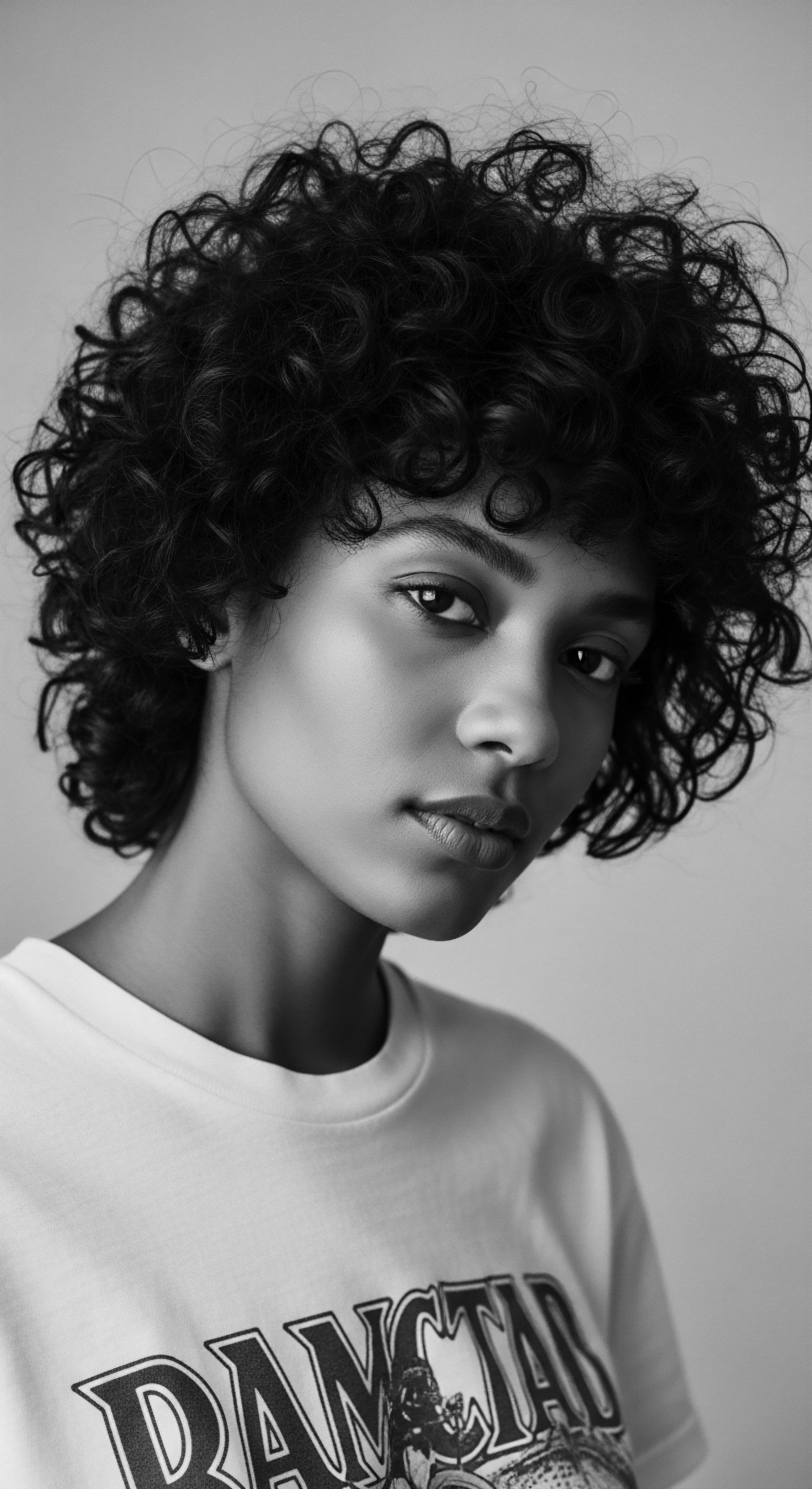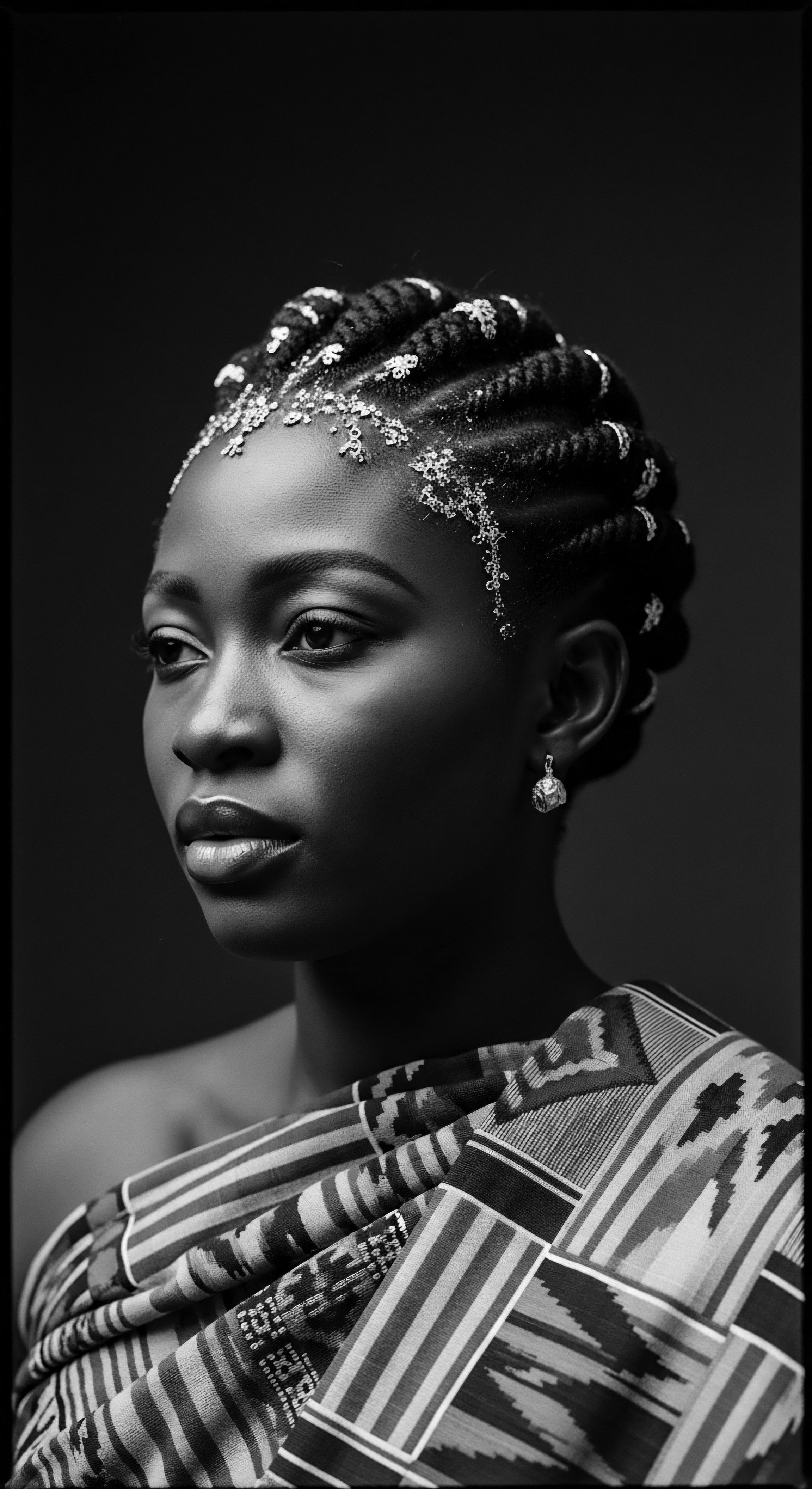
Roots
When one gazes upon the intricate curl or the resilient coil of textured hair, it is a sight that transcends mere aesthetics. It speaks of ancestral memory, of journeys across vast oceans, and of a profound connection to the earth itself. The story of African Black Soap, in conversation with West African hair heritage, begins not as a simple cleansing agent, but as a living echo from the soil, a testament to deep-seated wisdom passed through generations. For those whose lineage traces to the continent’s western shores, hair has always been more than an appendage; it has been a crown, a map, a library of identity.
How, then, does a substance born of ash and plant matter become so intertwined with the very biology and cultural narrative of these strands? It is through understanding the profound respect for natural elements and the communal spirit that shaped ancient West African life that we uncover this truth.

What does Textured Hair Reveal about Its Ancestral Blueprint?
Textured hair, with its unique helical structure, presents a distinct biological profile. Each strand possesses a flattened elliptical shape, and the hair follicle itself is often curved, leading to the characteristic curls, kinks, and coils. This inherent structure can make these strands more prone to dryness due to the winding path that natural oils must travel down the hair shaft. It can also exhibit areas of varied porosity, influencing how moisture is absorbed and retained.
Centuries before scientific microscopes unveiled these cellular details, West African communities understood, through observation and experience, the unique needs of their hair. They recognized that hair demanded particular care to thrive in diverse climates, from humid forests to drier savannas. This understanding shaped their practices, guiding them towards ingredients that would protect, nourish, and cleanse without stripping hair of its vital moisture. Their daily rituals were a practical science, honed over time, allowing for healthy growth and maintenance, a testament to an inherited understanding of natural hair’s biological truths.
African Black Soap stands as a historical testament to West African ingenuity in harmonizing nature’s bounty with textured hair’s inherent needs.

How Did West African Communities Categorize Hair Textures in Times Past?
Traditional West African societies did not employ modern numerical classification systems for hair, yet their understanding of hair texture was intricate, woven into the fabric of social language and cultural practices. Hair, in these contexts, often communicated much about an individual ❉ their Age, their Marital Status, their Tribal Affiliation, and even their social standing or spiritual beliefs (Gordon, as cited in Omotos, 2018). Hairstyles themselves were visual cues (Afriklens, 2024). The very act of hair grooming became a significant social activity, strengthening communal bonds (Creative Support, 2022).
Imagine a village setting where an elder’s hair might bear the marks of wisdom and experience, perhaps sculpted in a way that differs from a young woman’s braids signifying her transition to adulthood (Afriklens, 2024). This deep cultural embeddedness meant that the products used, including African Black Soap, were not simply utilitarian items. They were imbued with cultural meaning, selected for their efficacy in maintaining hair that spoke volumes. The soap’s ability to gently cleanse while preserving the hair’s natural integrity would have been prized, allowing diverse textures to be prepared for the symbolic styling that followed.
| Hair Texture Observation Tightly coiled strands with natural dryness tendencies. |
| Traditional Care Principle Prioritizing moisture retention and gentle cleansing. |
| African Black Soap Link Naturally hydrating, non-stripping cleansing (Baraka Shea Butter, 2023). |
| Hair Texture Observation Hair as a locus for communal identity and storytelling. |
| Traditional Care Principle Care practices that supported intricate, long-lasting styles. |
| African Black Soap Link Prepares hair for styling, maintains scalp health under protective styles. |
| Hair Texture Observation Varying textures within a single community or family. |
| Traditional Care Principle Versatility of natural ingredients to suit diverse needs. |
| African Black Soap Link Adaptable for various textures, providing balanced care (Niwel Beauty, 2024). |
| Hair Texture Observation African Black Soap's efficacy is rooted in its compatibility with the distinct biological and cultural aspects of West African textured hair. |

What Traditional Terms Describe Cleansing for West African Hair?
Within West African communities, the understanding of cleansing hair was deeply practical and often linked to the ingredients used. For instance, among the Yoruba people of Nigeria, African Black Soap is known as Ose Dudu (EcoFreax, 2023). This term itself carries weight, referring to a natural, dark soap. In Ghana, it might be called Alata Simena (EcoFreax, 2023).
These names are not merely labels; they are echoes of generations, signifying a product born of indigenous methods and local resources. The application of such a cleanser would have been part of a broader practice, involving communal gatherings where women, and sometimes men, prepared hair, sharing techniques and stories. The very act of washing would have been a ritual, a connection to the communal wisdom that understood how to keep hair healthy and vibrant. This holistic approach to cleansing ensured that hair was not merely clean but also respected, prepared for the intricate styles that signified identity and communal belonging.

Ritual
The hands that braid, the hands that oil, the hands that cleanse – these are the hands that carry heritage. In West Africa, hair care always stood as a ritual, a profound connection to tradition, a practice that transcended simple hygiene. African Black Soap found its place within these ceremonies, not by chance, but by virtue of its very composition and the age-old wisdom embedded in its making. It is a testament to the fact that beauty rituals were often deeply interwoven with daily life, communal bonds, and spiritual reverence.
When we speak of styling West African hair, we speak of an art form, a language communicated through intricate patterns and purposeful adornments. How did this ancestral cleanser support such artistry? It did so by providing the foundational care necessary for hair to be manipulated, protected, and celebrated.

How Did African Black Soap Facilitate Traditional Protective Styles?
West African protective styles, like the celebrated Cornrows, Braids, and Bantu Knots, were more than aesthetically pleasing arrangements; they served vital functional roles, shielding hair from environmental elements and minimizing breakage (Creative Support, 2022). These styles, often requiring hours of communal effort, found roots deeply planted in the history of various ethnic groups, including the Yoruba, Wolof, and Fulani (Afriklens, 2024). Before such intricate work could begin, the hair and scalp required thorough cleansing, yet without stripping essential oils, which could lead to dryness and fragility. African Black Soap, with its mild cleansing properties and often-included ingredients like shea butter and palm oil, would have been ideal.
It cleansed away impurities and product buildup, creating a clean canvas while simultaneously imparting conditioning elements (Baraka Shea Butter, 2023). This balance allowed the hair to be supple enough for precise braiding, ensuring the styles were not only visually appealing but also conducive to hair health. The soap became an ally in the longevity and integrity of these culturally significant styles, allowing them to remain resilient and expressive for extended periods.
The use of African Black Soap in hair care epitomizes West Africa’s ancestral knowledge of balancing purification with natural hair preservation.
The production of African Black Soap itself is a communal enterprise, often passed down through women (EcoFreax, 2023). This mirrors the communal aspect of hair styling in many West African cultures. A mother might wash her daughter’s hair with this soap, then proceed to braid it, sharing stories and wisdom, thereby strengthening both familial and cultural bonds. The soap, in this context, becomes a tangible link in a chain of inherited traditions, a bridge between generations and a vessel for cultural continuity.

What Traditional Tools Complemented the Cleansing and Styling Process?
Traditional West African hair care was not limited to cleansers; it involved a range of tools, often crafted from natural materials, each serving a specific purpose. Combs carved from Wood, Bone, or Metal were not merely functional objects but were often imbued with artistic and symbolic meaning (ResearchGate, 2024). These combs, alongside picking tools and sometimes even specialized sticks or fibers, helped detangle, section, and sculpt hair. Before these tools could effectively work through textured hair, particularly coiled strands, a proper cleansing and softening agent was paramount.
African Black Soap prepared the hair, making it more pliable and easier to manage, reducing tension and potential breakage during styling. The combination of gentle cleansing from the soap and careful manipulation with traditional tools allowed for the creation of styles that were not only beautiful but also maintained scalp health and hair integrity. The materials used in the soap itself—plantain skins, cocoa pods, palm leaves, shea butter—reflected the local flora, linking hair care directly to the land and its resources (Africa Imports, 2023).
- Shea Butter ❉ Found in many formulations of African Black Soap, it provides deep conditioning and moisture, essential for coiled hair (Baraka Shea Butter, 2023).
- Plantain Skins ❉ Rich in vitamins and minerals, contributing to the soap’s nourishing properties for scalp and hair (Africa Imports, 2023).
- Palm Oil ❉ A traditional ingredient that helps create a moisturizing lather, contributing to the soap’s conditioning effects (EcoFreax, 2023).

Relay
The journey of textured hair care, especially in West Africa, is a testament to an enduring connection between the self and the environment, a relay of wisdom passed from ancient healers to contemporary advocates. African Black Soap embodies this continuum, serving as a physical manifestation of ancestral knowledge and a beacon for holistic wellness. It is within this sphere that science begins to echo ancestral understanding, offering modern validation for practices that have sustained communities for centuries. The story of this soap is not just about cleansing; it is about problem-solving, about maintaining balance, and about fostering resilience in strands that have weathered time and hardship.

How does Ancestral Wisdom Inform Contemporary Textured Hair Care Practices?
The wisdom embedded in ancestral West African hair care practices extends beyond mere cosmetic application; it reflects a holistic understanding of well-being, where hair health was intrinsically tied to spiritual, communal, and physical vitality (Princeton University Art Museum). Hair was perceived as a medium to connect with the divine, a sacred crown (Afriklens, 2024). African Black Soap, with its natural, plant-derived ingredients, aligns perfectly with this philosophy.
It was crafted from the ashes of local vegetation, including Cocoa Pods, Plantain Skins, and Palm Tree Leaves, along with oils like Shea Butter and Palm Oil (Africa Imports, 2023). This composition meant that cleansing was also a ritual of nourishment, providing the scalp and hair with vitamins (A and E), antioxidants, and minerals like potassium and magnesium (Africa Imports, 2023).
A significant case study highlighting the enduring legacy of this approach is found in the continued use of traditional African Black Soap by individuals in the diaspora. Despite colonial pressures and the historical imposition of Eurocentric beauty standards which often led to chemical straightening of hair (The Gale Review, 2021; Creative Support, 2022), many Black individuals are returning to natural methods. Research by Ogunbiyi and Enechukwu (2021) notes that generations of Africans abroad continue to utilize modified versions of African Black Soap, reporting satisfaction with its results.
This enduring preference underscores a deep-seated trust in ancestral solutions and a desire to reconnect with heritage through self-care. The soap’s ability to cleanse without stripping natural oils is particularly beneficial for textured hair, which tends to be prone to dryness (Baraka Shea Butter, 2023).
The science behind African Black Soap validates much of this inherited wisdom. Studies have shown its antimicrobial properties against common skin microbiota, including Staphylococcus aureus and Candida albicans (Ogunbiyi & Enechukwu, 2021). This suggests that the soap’s historical use in treating scalp conditions and promoting overall scalp health was not anecdotal but supported by its biochemical composition. Its gentle exfoliation further aids in removing dead skin cells and product buildup, creating an optimal environment for hair growth and reducing issues like dandruff and irritation (Baraka Shea Butter, 2023).
African Black Soap’s continued relevance is a powerful affirmation of inherited care rituals and their profound ability to support textured hair’s well-being.

How does African Black Soap Address Common Textured Hair Concerns?
Textured hair, with its unique structure, often faces challenges such as dryness, breakage, and scalp irritation. African Black Soap, through its traditional formulation, inherently addresses these concerns. Its rich blend of plant-based ingredients helps to retain moisture, leaving hair soft and manageable (Baraka Shea Butter, 2023).
The vitamins and antioxidants within the soap, particularly from components like shea butter and plantain peel ash, are instrumental in nourishing hair follicles, strengthening strands, and reducing breakage (Baraka Shea Butter, 2023). This natural formulation avoids harsh chemicals often found in commercial shampoos that can strip textured hair of its vital lipids, leading to further dryness (nappilynigeriangirl, 2015).
The ancestral approach to hair care often involved careful attention to the scalp, recognizing it as the foundation of healthy hair. African Black Soap’s inherent properties soothe scalp irritation and help combat dandruff, fostering a balanced scalp environment conducive to healthy growth (Baraka Shea Butter, 2023). This alignment between traditional understanding and modern scientific validation underscores the soap’s role as a staple in textured hair care, not just for cleansing, but for holistic scalp and hair health. It is a product that speaks to the continuous legacy of care, a legacy that respects the intricate nature of textured hair and seeks to preserve its vitality.
The nighttime ritual, a cornerstone of protecting textured hair, also benefits from the foundational cleanliness provided by African Black Soap. While the soap itself is used during washing, a clean, balanced scalp sets the stage for the efficacy of subsequent nighttime practices, such as moisturizing, sealing, and protecting strands with silk or satin coverings. These practices, rooted in the understanding of hair’s vulnerability during sleep, are enhanced by a cleansing agent that does not undo the day’s efforts at hydration and health.
- Traditional Scalp Health ❉ African Black Soap’s properties contribute to a clean, balanced scalp, a practice central to West African hair care traditions for optimal growth.
- Moisture Balance ❉ Its natural ingredients aid in moisture retention, addressing the inherent dryness often associated with textured hair, a concern understood by ancestral practitioners.
- Ingredient Purity ❉ The soap’s plant-based composition aligns with the historical reliance on local, natural resources for hair nourishment, connecting modern use to a heritage of purity.

Reflection
The journey of African Black Soap, from the communal pots of West African villages to its presence in modern hair care, speaks to a heritage that refuses to be silenced. It is a story told not just through words, but through the resilience of coiled strands, the shared laughter during braiding rituals, and the deep, abiding respect for the earth’s offerings. The ‘Soul of a Strand’ beats with this rhythm, recognizing that each curl holds a universe of history, wisdom, and an ancestral promise.
African Black Soap is more than a cleanser; it is a living artifact, a bridge across time, connecting us to the hands that first crafted it, the knowledge that guided those hands, and the communities that thrived because of such profound understanding. It reminds us that true radiance stems from a reverence for our origins, a continuous dialogue between the past and the present, ensuring that the legacy of textured hair heritage continues to shape futures, unbound and undeniably radiant.

References
- Afriklens. (2024). African Hairstyles ❉ Cultural Significance and Legacy.
- Africa Imports. (2023). Traditional African Secrets For Long And Healthy Hair.
- Baraka Shea Butter. (2023). 3 Benefits Of African Black Soap For Hair (Detailed).
- Creative Support. (2022). The History of Black Hair.
- EcoFreax. (2023). African Black Soap ❉ The Natural Wonder for Skin and Hair.
- nappilynigeriangirl. (2015). The Problem With Black Soap For Natural Hair.
- Niwel Beauty. (2024). Black soap (also) protects your hair!
- Ogunbiyi, A. & Enechukwu, N. A. (2021). African black soap ❉ Physiochemical, phytochemical properties, and uses. Dermatol Ther. 34(3), e14870.
- Omotos, A. (2018). Hair was very important in ancient African civilizations. Journal of Pan African Studies.
- Princeton University Art Museum. (n.d.). Hair and the Head.
- ResearchGate. (2024). Conflicting Tensions in Decolonising Proscribed Afrocentric Hair Beauty Culture Standards in Ghanaian Senior High Schools.
- The Gale Review. (2021). African Hairstyles – The “Dreaded” Colonial Legacy.
